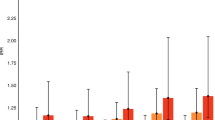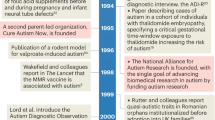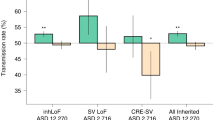Abstract
Advanced paternal age has been suggested as a risk factor for autism, but empirical evidence is mixed. This study examines whether the association between paternal age and autism in the offspring (1) persists controlling for documented autism risk factors, including family psychiatric history, perinatal conditions, infant characteristics and demographic variables; (2) may be explained by familial traits associated with the autism phenotype, or confounding by parity; and (3) is consistent across epidemiological studies. Multiple study methods were adopted. First, a Swedish 10-year birth cohort (N=1 075 588) was established. Linkage to the National Patient Register ascertained all autism cases (N=883). Second, 660 families identified within the birth cohort had siblings discordant for autism. Finally, meta-analysis included population-based epidemiological studies. In the birth cohort, autism risk increased monotonically with increasing paternal age. Offspring of men aged ⩾50 years were 2.2 times (95% confidence interval: 1.26–3.88: P=0.006) more likely to have autism than offspring of men aged ⩽29 years, after controlling for maternal age and documented risk factors for autism. Within-family analysis of discordant siblings showed that affected siblings had older paternal age, adjusting for maternal age and parity (P<0.0001). Meta-analysis demonstrated advancing paternal age association with increased risk of autism across studies. These findings provide the strongest evidence to date that advanced paternal age is a risk factor for autism in the offspring. Possible biological mechanisms include de novo aberration and mutations or epigenetic alterations associated with aging.
This is a preview of subscription content, access via your institution
Access options
Subscribe to this journal
Receive 12 print issues and online access
$259.00 per year
only $21.58 per issue
Buy this article
- Purchase on Springer Link
- Instant access to full article PDF
Prices may be subject to local taxes which are calculated during checkout


Similar content being viewed by others
References
American-Psychiatric-Association. Diagnostic and Statistical Manual of Mental Disorders, 4th edn. APA: Washington DC, 1994.
Bailey A, Le Couteur A, Gottesman I, Bolton P, Simonoff E, Yuzda E et al. Autism as a strongly genetic disorder: evidence from a British twin study. Psychol Med 1995; 25: 63–77.
Newschaffer CJ, Fallin D, Lee NL . Heritable and nonheritable risk factors for autism spectrum disorders. Epidemiol Rev 2002; 24: 137–153.
Lian ZH, Zack MM, Erickson JD . Paternal age and the occurrence of birth defects. Am J Hum Genet 1986; 39: 648–660.
Tolarova MM, Harris JA, Ordway DE, Vargervik K . Birth prevalence, mutation rate, sex ratio, parents’ age, and ethnicity in Apert syndrome. Am J Med Genet 1997; 72: 394–398.
Durkin MS, Maenner MJ, Newschaffer CJ, Lee LC, Cunniff CM, Daniels JL et al. Advanced parental age and the risk of autism spectrum disorder. Am J Epidemiol 2008; 168: 1268–1276.
Croen LA, Najjar DV, Fireman B, Grether JK . Maternal and paternal age and risk of autism spectrum disorders. Arch Pediatr Adolesc Med 2007; 161: 334–340.
Reichenberg A, Gross R, Weiser M, Bresnahan M, Silverman J, Harlap S et al. Advancing paternal age and autism. Arch Gen Psychiatry 2006; 63: 1026–1032.
Lauritsen MB, Pedersen CB, Mortensen PB . Effects of familial risk factors and place of birth on the risk of autism: a nationwide register-based study. J Child Psychol Psychiatry 2005; 46: 963–971.
Daniels JL, Forssen U, Hultman CM, Cnattingius S, Savitz DA, Feychting M et al. Parental psychiatric disorders associated with autism spectrum disorders in the offspring. Pediatrics 2008; 121: e1357–e1362.
Larsson HJ, Eaton WW, Madsen KM, Vestergaard M, Olesen AV, Agerbo E et al. Risk factors for autism: perinatal factors, parental psychiatric history, and socioeconomic status. Am J Epidemiol 2005; 161: 916–925; discussion 926–928.
Glasson EJ, Bower C, Petterson B, de Klerk N, Chaney G, Hallmayer JF . Perinatal factors and the development of autism: a population study. Arch Gen Psychiatry 2004; 61: 618–627.
Maimburg RD, Vaeth M . Perinatal risk factors and infantile autism. Acta Psychiatr Scand 2006; 114: 257–264.
Puleo CM, Reichenberg A, Smith CJ, Kryzak LA, Silverman JM . Do autism-related personality traits explain higher paternal age in autism? Mol Psychiatry 2008; 13: 243–244.
Piven J . The broad autism phenotype: a complementary strategy for molecular genetic studies of autism. Am J Med Genet 2001; 105: 34–35.
Bailey A, Palferman S, Heavey L, Le Couteur A . Autism: the phenotype in relatives. J Autism Dev Disord 1998; 28: 369–392.
Hultman CM, Sparen P, Cnattingius S . Perinatal risk factors for infantile autism. Epidemiology 2002; 13: 417–423.
World Health Organization. International Classification of Diseases, Ninth Revision (ICD-9). World Health Organization: Geneva Switzerland, 1977.
World Health Organization. International Statistical Classification of Diseases, Tenth Revision (ICD-10). World Health Organization: Geneva, Switzerland, 1992.
Ekholm B, Ekholm A, Adolfsson R, Vares M, Osby U, Sedvall GC et al. Evaluation of diagnostic procedures in Swedish patients with schizophrenia and related psychoses. Nord J Psychiatry 2005; 59: 457–464.
Lauritsen MB, Jorgensen M, Madsen KM, Lemcke S, Toft S, Grove J et al. Validity of childhood autism in the Danish Psychiatric Central Register: findings from a cohort sample born 1990–1999. J Autism Dev Disord 2010; 40: 139–148.
Bertrand J, Mars A, Boyle C, Bove F, Yeargin-Allsopp M, Decoufle P . Prevalence of autism in a United States population: the Brick Township, New Jersey, investigation. Pediatrics 2001; 108: 1155–1161.
Madsen KM, Hviid A, Vestergaard M, Schendel D, Wohlfahrt J, Thorsen P et al. A population-based study of measles, mumps, and rubella vaccination and autism. N Engl J Med 2002; 347: 1477–1482.
Kolevzon A, Gross R, Reichenberg A . Prenatal and perinatal risk factors for autism: a review and integration of findings. Arch Pediatr Adolesc Med 2007; 161: 326–333.
King MD, Fountain C, Dakhlallah D, Bearman PS . Estimated autism risk and older reproductive age. Am J Public Health 2009; 99: 1673–1679.
Grether JK, Anderson MC, Croen LA, Smith D, Windham GC . Risk of autism and increasing maternal and paternal age in a large North American population. Am J Epidemiol 2009; 170: 1118–1126.
Reichenberg A, Gross R, Sandin S, Susser ES . Advancing paternal and maternal age are both important for autism risk. Am J Public Health 2010; 100: 772–773; author reply 773.
Rothman KJ, Greenland S . Modern Epidemiology. 2nd edn. Lippincott Williams & Wilkins: Philadelphia, PA, USA, 1998, pp 737.
Hastie TJ, Tibshirani RJ . Generalized Additive Models. Chapman & Hall: New-York, NY, 1990.
Liang KY, Zeger SL . Longitudinal data analysis using generalized linear models. Biometrika 1986; 73: 13–22.
Diggle PJ, Liang KY, Zeger SL . Analysis of Longitudinal Data. Oxford Science Publications: Oxford, UK, 1994.
Pawitan Y . In All Likelihood: Statistical Modelling and Inference Using Likelihood. Oxford University Press: Oxford, UK, 2001.
Stroup DF, Berlin JA, Morton SC, Olkin I, Williamson GD, Rennie D . Meta-analysis of observational studies in epidemiology: a proposal for reporting. Meta-analysis Of Observational Studies in Epidemiology (MOOSE) group. JAMA 2000; 283: 2008–2012.
McDonald S, Taylor L, Adams C . Searching the right database: a comparison of four databases for psychiatry journals. Health Libr Rev 1999; 16: 151–156.
Lumley T . R-Meta Package, 2.14 edn (http://cran.ma.imperial.ac.uk/), 2008.
Sasanfar R, Haddad SA, Tolouei A, Ghadami M, Yu D, Santangelo SL . Paternal age increases the risk for autism in an Iranian population sample. Mol Autism 2010; 1: 2.
Bohman M, Bohman IL, Bjorck PO, Sjoholm E . Childhood psychosis in a Northern Swedish county: some preliminary findings from an epidemiological survey. In: Schmidt MH, Remschmidt H (eds). Epidemiological Approaches in Child Psychiatry. Georg Thieme Verlag: Stuttgart, 1983, pp 164–173.
Gillberg C, Steffenburg S, Schaumann H . Is autism more common now than ten years ago? Br J Psychiatry 1991; 158: 403–409.
Fombonne E . Epidemiological surveys of autism and other pervasive developmental disorders: an update. J Autism Dev Disord 2003; 33: 365–382.
Lundstrom S, Haworth CM, Carlstrom E, Gillberg C, Mill J, Rastam M et al. Trajectories leading to autism spectrum disorders are affected by paternal age: findings from two nationally representative twin studies. J Child Psychol Psychiatry 2010; 51: 850–856.
Shelton JF, Tancredi DJ, Hertz-Picciotto I . Independent and dependent contributions of advanced maternal and paternal ages to autism risk. Autism Res 2010; 3: 30–39.
Bilder D, Pinborough-Zimmerman J, Miller J, McMahon W . Prenatal, perinatal, and neonatal factors associated with autism spectrum disorders. Pediatrics 2009; 123: 1293–1300.
Crow JF . The origins, patterns and implications of human spontaneous mutation. Nat Rev Genet 2000; 1: 40–47.
Buwe A, Guttenbach M, Schmid M . Effect of paternal age on the frequency of cytogenetic abnormalities in human spermatozoa. Cytogenet Genome Res 2005; 111: 213–228.
Reichenberg A, Mill J, MacCabe J . Epigenetics, genomic mutations and cognitive function. Cogn Neuropsychiatry 2009; 14: 377–390.
Marshall CR, Noor A, Vincent JB, Lionel AC, Feuk L, Skaug J et al. Structural variation of chromosomes in autism spectrum disorder. Am J Hum Genet 2008; 82: 477–488.
Sebat J, Lakshmi B, Malhotra D, Troge J, Lese-Martin C, Walsh T et al. Strong association of de novo copy number mutations with autism. Science 2007; 316: 445–449.
Mill J, Tang T, Kaminsky Z, Khare T, Yazdanpanah S, Bouchard L et al. Epigenomic profiling reveals DNA-methylation changes associated with major psychosis. Am J Hum Genet 2008; 82: 696–711.
Flanagan JM, Popendikyte V, Pozdniakovaite N, Sobolev M, Assadzadeh A, Schumacher A et al. Intra- and interindividual epigenetic variation in human germ cells. Am J Hum Genet 2006; 79: 67–84.
Yauk C, Polyzos A, Rowan-Carroll A, Somers CM, Godschalk RW, Van Schooten FJ et al. Germ-line mutations, DNA damage, and global hypermethylation in mice exposed to particulate air pollution in an urban/industrial location. Proc Natl Acad Sci USA 2008; 105: 605–610.
Chakrabarti S, Fombonne E . Pervasive developmental disorders in preschool children. JAMA 2001; 285: 3093–3099.
Tsuchiya KJ, Matsumoto K, Miyachi T, Tsujii M, Nakamura K, Takagai S et al. Paternal age at birth and high-functioning autistic-spectrum disorder in offspring. Br J Psychiatry 2008; 193: 316–321.
Croen LA, Grether JK, Selvin S . Descriptive epidemiology of autism in a California population: who is at risk? J Autism Dev Disord 2002; 32: 217–224.
Eaton WW, Mortensen PB, Thomsen PH, Frydenberg M . Obstetric complications and risk for severe psychopathology in childhood. J Autism Dev Disord 2001; 31: 279–285.
Smith RG, Kember RL, Mill J, Fernandes C, Schalkwyk LC, Buxbaum JD et al. Advancing paternal age is associated with deficits in social and exploratory behaviors in the offspring: a mouse model. PLoS One 2009; 4: e8456.
Foldi CJ, Eyles DW, McGrath JJ, Burne TH . Advanced paternal age is associated with alterations in discrete behavioural domains and cortical neuroanatomy of C57BL/6J mice. Eur J Neurosci 2010; 31: 556–564.
World Health Organization. Manual of the International Statistical Classification of Diseases, Eight Revision (ICD-8). World Health Organization: Geneva, Switzerland, 1967.
Acknowledgements
This work was supported by a grant from the Swedish Council for Working Life and Social Research (guest research fellowship to A Reichenberg). The Swedish Council for Working Life and Social Research was not involved in the design and conduct of the study; collection, management, analysis and interpretation of the data; or in the preparation, review or approval of the manuscript. Approval to access the registries was given by the Swedish National Board of Health and Welfare, and the study was approved by a local human subjects committee at the Karolinska Institutet (Stockholm, Sweden).
Author Contributions: Drs Hultman, Reichenberg and Sandin had full access to all of the data in the study and take responsibility for the integrity of the data and the accuracy of the data analysis.
Study concept and design: Reichenberg, Sandin, Hultman and Lichtenstein.
Acquisition of data: Hultman and Sandin.
Analysis and interpretation of data: Hultman, Reichenberg, Sandin, Lichtenstein and Levine.
Drafting of the manuscript: Hultman and Reichenberg.
Critical revision of the manuscript for important intellectual content: Hultman, Reichenberg, Sandin, Lichtenstein and Levine.
Statistical analysis: Sandin, Levine and Reichenberg.
Obtained funding: Hultman.
Administrative, technical, or material support: Hultman, Lichtenstein.
Study supervision: Hultman and Reichenberg.
Author information
Authors and Affiliations
Corresponding author
Ethics declarations
Competing interests
The authors declare no conflict of interest.
Additional information
Supplementary Information accompanies the paper on the Molecular Psychiatry website
Supplementary information
PowerPoint slides
Rights and permissions
About this article
Cite this article
Hultman, C., Sandin, S., Levine, S. et al. Advancing paternal age and risk of autism: new evidence from a population-based study and a meta-analysis of epidemiological studies. Mol Psychiatry 16, 1203–1212 (2011). https://doi.org/10.1038/mp.2010.121
Received:
Revised:
Accepted:
Published:
Issue Date:
DOI: https://doi.org/10.1038/mp.2010.121
Keywords
This article is cited by
-
Associations of parental mental disorders and age with childhood mental disorders: a population-based cohort study with four million offspring
European Child & Adolescent Psychiatry (2023)
-
OBGYN providers’ lack of knowledge and management of genetic risks due to advanced paternal age underscore the need for updated practice guidance
Journal of Community Genetics (2022)
-
Disturbances in primary dental enamel in Polish autistic children
Scientific Reports (2020)
-
A meta-analysis of two high-risk prospective cohort studies reveals autism-specific transcriptional changes to chromatin, autoimmune, and environmental response genes in umbilical cord blood
Molecular Autism (2019)
-
Associations of parental age with offspring all-cause and cause-specific adult mortality
Scientific Reports (2019)



